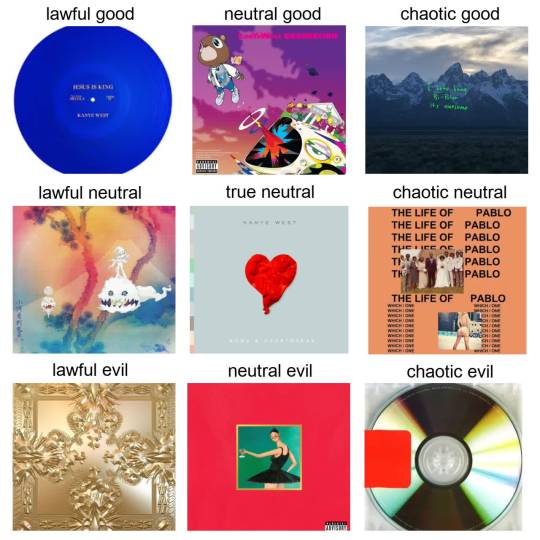Are you a Kanye West fan that also likes Dungeons and Dragons? If so, welcome to the club – there’s several of us! Below is my take on 9 Kanye albums according to the DnD alignment system:

Jesus is King (Lawful Good): This album represents Kanye at his most (self) righteous. Every year marks the emergence of a new Kanye, and in 2019 he announced he was committed to rapping for God and God only. Perhaps it was an early onset of the manic episode fueling his 2020 presidential run, but I believe his intentions were pure on Jesus is King.
Graduation (Neutral Good): On this album, Kanye spends more time celebrating his achievements than criticizing the establishment. For this reason, Graduation is aligned with Good without any leanings towards law nor chaos.
ye (Chaotic Good): In my opinion, ye represents Kanye at his most vulnerable, and it is undoubtedly chaotic. This album ranges from the manic highs on “Ghost Town” to introspective lows on “I Thought About Killing You”. All of this paints a vivid picture of Kanye as a highly flawed superstar who, deep down, still has a lot of heart.
Kids See Ghosts (Lawful Neutral): With tracks like “Kids See Ghosts” and “Reborn”, KSG is one of Kanye’s most meditative projects, and balances the forces of good and evil.
808s & Heartbreak (True Neutral): By far Kanye’s most depressing work. There is no preoccupation with good nor evil, law nor chaos on 808s – just heartbreak.
The Life of Pablo (Chaotic Neutral): As the album that Kanye famously released multiple times, it’s easy to see that TLOP is chaotic. It also has a healthy balance of good (“Ultralight Beam”, “Real Friends”) and evil (“Father Stretch My Hands Pt. 1”, “Freestyle 4”) that cancel out for a neutral alignment.
Watch the Throne (Lawful Evil): The power trip that gave us My Beautiful Dark Twisted Fantasy is still evident of 2011’s Watch the Throne with Jay-Z. This album is all about being at the top and staying there by any means necessary.
My Beautiful Dark Twisted Fantasy (Neutral Evil): MBDTF oozes decadence and indulgence. If this album were a period in Roman History, it would be the late period. Songs like “Hell Of A Life” and “POWER” exemplify why this album aligns with Neutral Evil.
Yeezus (Chaotic Evil): Yeezus found Kanye at the height of his God complex – case in point: “I Am A God”. Furthermore, the jagged, industrial production throughout lends itself to the chaotic alignment.
That’s it! What do you think of my Kanye West alignment chart? What do you agree with? What would you change?
– DJ Mango


